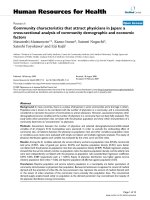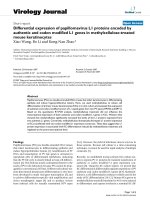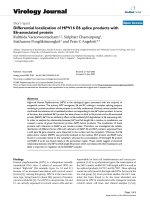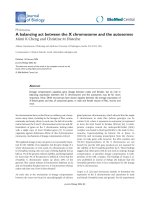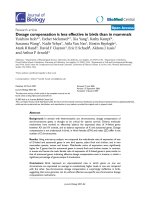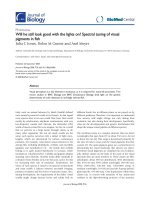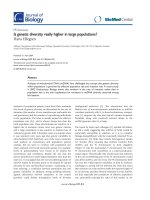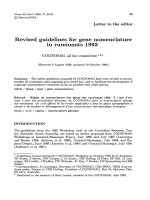Báo cáo sinh học: " Differential sister chromatid exchange response in phytohemagglutinin and pokeweed stimulated lymphocytes of goat (Capra hircus L)" potx
Bạn đang xem bản rút gọn của tài liệu. Xem và tải ngay bản đầy đủ của tài liệu tại đây (488.29 KB, 8 trang )
Original
article
Differential
sister
chromatid
exchange
response
in
phytohemagglutinin
and
pokeweed
stimulated
lymphocytes
of
goat
(Capra
hircus
L)
D
Di
Berardino
V
Jovino
A
Crasto
MB
Lioi
MR
Scarfi
I
Burguete
!
Department
of
Animal
Science,
University
of
Naples
’Federico
II’,
80055
Portici,
Naples;
2
Department
of
Animal
Production,
University
of
Basilicata,
Via
N
Sauro
85,
85100
Potenza;
3
CNR-IRECE,
80124
Naples,
Italy
4
Department
of
Animal
Production,
University
of
Murcia,
Espinardo,
30071
Murcia,
Spain
(Received
3
June
1996;
accepted
21
January
1997)
Summary -
A
differential
sister
chromatid
exchange
(SCE)/cell
response
was
observed
between
phytohemagglutinin
(PHA)
and
pokeweed
(PKW)
stimulated
blood
lymphocytes
of
goat
(Capra
hircus
L)
exposed
to
final
concentrations
of
0.1,
0.25,
0.5,
1,
2.5
and
5
pg/mL
of
BUdR.
At
0.1
!g/mL
of
BUdR,
the
two
mitogens
gave
very
similar
SCE/cell
responses:
the
SCE
mean
values
were
3.17 !
1.93
for
PHA
and
3.28 !
1.76
for
PKW,
and
the
frequency
distributions
fit
very
well
the
Poisson
probability
function
with
both
mitogens.
For
0.25
v
g/mL
and
increasing
BUdR
concentrations,
SCE/cell
rates
for
pokeweed
mitogen
were
significantly
higher
than
those
of
PHA.
At
5
4
g/mL
of
BUdR,
the
SCE/cell
response
was
8.68 !
3.24
for
PKW
and
6.96 !
3.45
for
PHA,
and
the
difference
was
statistically
significant
(P
=
0.0001);
for
both
mitogens
the
SCE/cell
frequency
distributions
fit
the
Poisson
probability
function
only
by
adopting
a
Poisson
’mixture’
model,
which
takes
into
account
the
presence
of
two
different
subpopulations
of
cells.
sister
chromatid
exchange
/
phytohemagglutinin
/
pokeweed
/
Poisson
distribution
/
goat
Résumé -
Effets
différentiels
de
la
phytohémagglutinine
et
du
phytolaque
sur
les
échanges
entre
chromatides
soeurs
chez
les
lymphocytes
de
la
chèvre.
Une
réponse
différentielle
pour
le
nombre
d’échanges
entre
chromatides
soeurs
a
été
observée
entre
les
lymphocytes
de
chèvre
(Capra
Hircus
L)
stimulés
par
la
phytohémagglutinine
(PHA)
ou
le
phytolaque
(PKW),
après
exposition
à
des
concentrations
finales
de
0,1,
0,25,
0,5,
1,
2,
5
et
5
pg/mL
de
B UdR.
A
0,1
pg/mL
de
B UdR,
les
deux
mitogènes
ont
donné
une
réponse
SCE/
cellules
très
similaire :
les
valeurs
moyennes
ont
été
de
3,17 ::!:
1, 93
pour
PHA
et
de
3, 28 !
1, 76
pour
PKW,
et
les
distributions
de
fréquences
se
sont
très
bien
ajustées
à
une
loi
de
Poisson
pour
les
deux
mitogënes.
À
partir
de
0,25 J1g/mL,
les
réponses
à
PKW
ont
toujours
été
supérieures
à
celles
correspondant
à
PHA.
À
partir
de
5
J1
g/mL
de
BUdR,
la
réponse
SCE/ cellule
a
été
de
8, 68
t
3, 24
pour
PKW
et
6, 96 !
3,45
pour
PHA
et
la
différence
a
été
significative.
La
distribution
de
fréquence
pour
l’ensemble
des
mitogènes
s’est
très
bien
ajustée
à
un
mélangé
de
dezlx
lois
de
Poisson,
correspondant
aux
deux
populations
de
cellules
concernées
par
chaque
mitogène.
échange
entre
chromatides
/
phytohémagglutinine
/
phytolaque
/
comparaison
/
chèvres
INTRODUCTION
Sister
chromatid
exchange
(SCE)
is
considered
to
be
an
important
cytogenetic
test
for
monitoring
cytogenetic
damage
induced
by
environmental
mutagens
(Carrano
et
al,
1978)
as
well
as
for
detecting
chromosome
instability
conditions
such
as
the
Bloom
syndrome
in
humans
(Chaganti
et
al,
1974).
SCE
studies
reported
in
humans
as
well
as
in
other
mammalian
species
have
largely
indicated
several
important
factors
that
can
influence
the
frequency
of
SCE:
BUdR
concentration
(Wolff
and
Perry,
1974;
Kato,
1974),
visible
light
(Ikushima
and
Wolff,
1974),
type
and
amount
of
serum
(Kato
and
Sandberg,
1977),
exogenous
viruses
(Kato,
1977),
cell
cycle
duration
(Snope
and
Rary,
1979),
growth
temperature
(Speit,
1980),
composition
and
type
of
medium
(Mutchinick
et
al,
1980),
proportion
of
B and
T
lymphocytes
(Lindblad
and
Lambert,
1981),
antibiotics
and
serum
(Das
and
Sharma,
1983),
sex
and
age
(Soper
et
al,
1984),
dietary
habits
(Wulf
et
al,
1986),
group,
animal
and
BUdR
treatment
(Catalan
et
al,
1994;
Iannuzzi
et
al,
1991a).
As
is
known,
in
vitro
SCE
studies
are
routinely
carried
out
on
peripheral
blood
lymphocytes
stimulated
either
with
phytohemagglutinin
(PHA-M
form)
or
with
pokeweed
(PKW)
mitogens;
the
choice
between
them
mainly
depends
upon
how
much
hemagglutination
is
tolerated
in
the
cultures;
furthermore,
pokeweed
stimulates
both
classes
of
B and
T
lymphocytes,
whereas
phytohemagglutinin
mainly
stimulates
T
lymphocytes
(Rooney
and
Czepulkowsky,
1986).
Since
the
proportion
of
B and
T
lymphocytes
in
the
blood
and,
to
a
greater
extent,
the
rate
of
cell
proliferation
in
the
culture
system
have
been
indicated
as
important
factors
affecting
the
SCE/cell
frequency
(Santesson
et
al,
1979;
Lindblad
and
Lambert,
1981)
it
is
likely
that
the
mitogen
used
in
the
culture
system
might
well
influence
the
final
SCE/response.
The
present
study
refers
to
the
differential
SCE/cell
response
observed
in
blood
lymphocytes
of
goat
( Capra
hircus
L)
stimulated
with
PHA
and
PKW,
and
exposed
to
final
concentrations
of
0.1,
0.25,
0.5,
1,
2.5
and
5
vg/mL
of
BUdR.
MATERIALS
AND
METHODS
Venous
blood
was
aseptically
collected
from
four
goats
(two
males
and
two
females)
of
the
Jonica
breed,
reared
in
a
farm
located
in
Villa
Literno,
province
of
Caserta;
the
animals
were
clinically
healthy
and
unrelated.
Aliquots
of
0.5
mL
of
whole
heparinized
blood
were
cultured
at
37.5
°C
in
9.5
mL
of RPMI
1640
medium
(Gibco,
Dutch
modification),
containing
10%
fetal
calf
serum
(Gibco),
0.1
mL
L-glutamine
(Gibco),
30
vL
of
antibiotics
and
50
!iL
of
fungizone.
For
each
animal
12
culture
flasks
were
prepared,
six
stimulated
with
0.1
mL
phytoemagglutinin
and
six
with
0.1
mL
pokeweed
mitogens
(both
from
Gibco).
After
36
h
of
growth,
BUdR
(Sigma,
Saint
Louis,
MO,
USA)
was
added
at
final
concentrations
of
0.1,
0.25,
0.5,
1,
2.5
and
5
pg/mL,
respectively,
for
the
PHA
and
PKW
sets
of
flasks.
The
cultures
were
protected
from
light
and
allowed
to
grow
for
an
additional
36
h.
Colcemid
was
added
for
the
final
60
min.
Harvested
cells
were
treated
with
hypotonic
solution
(KCI,
0.075
M)
for
20
min
at
37.5
°C
and
fixed
three
times
with
methanol/acetic
acid
solution
3:1.
Air
dried
slides
were
stained
with
a
0.2%
acridine
orange
solution
in
phosphate
buffer
(pH
=
7.0)
for
10
min,
washed
thoroughly
in
tap
water,
mounted
in
phosphate
buffer
and
sealed
with
paraffin.
SCEs
were
counted
on
50
second
cycle
metaphase
spreads,
randomly
scored
for
each
animal,
for
each
BUdR
level.
All
scoring
was
performed
by
the
same
person.
Statistical
note:
For
each
BUdR
dose
and
for
both
mitogens,
data
were
anal-
ysed
by
means
of
Poisson’s
probability
function,
where
the
expected
values
were
calculated
using
the
following
formula:
The
chi
square
method
was
utilized
to
estimate
the
goodness
of
fit
between
observed
and
expected
values.
At
the
lowest
BUdR
dose
Poisson’s
probability
function
fit
very
well
the
observed
data
for
both
PHA
and
PKW
mitogens.
Conversely,
at
the
highest
BUdR
dose
the
fit
was
not
observed
for
either
mitogens.
Therefore,
at
5.0
!tg/mL
of
BUdR
a
Poisson
’mixture’
model
was
used.
The
’Poisson
mixture’
is
a
non-linear
regression
function
that
allows
the
estimation,
through
the
least
squares
method,
of
the
unknown
parameters
y,
!1,
!2,
which
minimize
the
expression
.!1
and
A2
represent
the
’means’, -!
and
(1 -
ry)
the
relative
percentages
of
the
two
subpopulations
of
B and
T
lymphocytes.
The
fitness
of
the
function
is
evaluated
through
the
R2
coefficients.
RESULTS
Table
I
shows
the
individual
mean
rates
and
standard
deviations
of
SCE/cell
at
increasing
doses
of
BUdR
in
PHA
and
PKW
stimulated
goat
lymphocytes.
At
0.1
vg/mL
of
BUdR
the
SCE/cell
rates
of
the
two
mitogens
are
very
similar
(3.28 !
1.76
for
PKW,
3.17 !
1.93
for
PHA),
the
difference
not
being
statistically
significant;
at
5.0
!g/mL
of
BUdR,
PKW
values
are
significantly
higher
compared
to
the
PHA
ones
(8.68 ! 3.24
versus
6.96 ! 3.45,
respectively)
(P
=
0.0001).
From
a
BUdR
concentration
of
0.25
ug/mL
and
above,
PKW
values
are
significantly
higher
than
PHA
values.
Figure
1
visualizes
the
differential
SCE/cell
dose-response
relationships
between
the
two
mitogens.
Basically,
the
two
curves
start
from
the
same
level;
PHA
rates
increase
more
slowly
and
regularly
compared
to
PKW
ones,
which
increase
more
rapidly
from
0.1
to
0.5
!g/ml
of BUdR,
remain
fairly
constant
from
0.5
to
1
[i
g/mL,
and
increase
again
up
to
5
wg/mL.
By
extrapolating
the
two
curves
beyond
the
dosage
of
5
!Lg/mL,
the
SCE/cell
values
scored
on
PKW
stimulated
lymphocytes
would
likely
continue
to
remain
higher
compared
to
those
for
PHA.
In
order
to
verify
whether
the
number
of
cells
examined
would
have
any
significant
effect
on
the
estimated
means
we
extended
the
observations
to
50
more
second
cycle
metaphase
plates
at
dosages
of
0.1
and
5.0
vg/mL
of
BUdR.
By
doubling
the
number
of
observations
from
50
to
100
the
’means’
estimated
over
the
first
50
do
not
change
significantly.
In
order
to
study
the
variation
in
the
SCE/cell
distributions
within
the
cell
pop-
ulations,
only
the
lowest
and
the
highest
dosages
were
selected
and
the
individual
SCE/cell
values
were
scored
on
100
cells
for
each
donor
and
pooled,
summing
up
to
400
cells
for
each
BUdR
level.
Figure
2
shows
the
observed
(obs),
Poisson
expected
(exp)
and
Poisson
’mixture’
expected
(exp
a)
SCE/cell
distributions
at
0.1
and
5
!g/mL
of
BUdR,
respectively,
for
PHA
and
PKW
stimulated
lymphocytes.
At
0.1
!ig/mL
of
BUdR
both
mitogens
behave
in
a
similar
fashion,
and
the
Poisson
frequencies
fit
very
well
(chi
square
=
15.31
for
PHA
and
6.98
for
PKW;
chi
square
0.05
=
18.3
and
15.5,
respectively).
At
high
BUdR
levels
(5
!tg/mL)
the
two
mitogens
deviate
significantly
in
their
behaviour,
and
the
Poisson
frequencies
do
not
fit
anymore
(chi
square
=
49.3
for
PHA
and
28.61
for
PKW;
chi
square
0.05
=
25
and
26.3,
respectively).
However,
when
the
SCE
expected
frequencies
are
calculated
on
the
basis
of
a
Poisson
’mixture’
function,
they
again
fit
the
observed
frequencies
(chi
square
=
5.4
and
13.56
for
PHA
and
PKW,
respectively:
adjusted
R2
=
0.98
and
0.94,
respectively).
DISCUSSION
The
results
of
the
present
study
clearly
indicate
that
at
0.1
¡.¡.g/mL
of
BUdR,
the
two
mitogens
have
SCE/cell
rates
that
are
strikingly
similar
to
each
other,
and
the
Poisson
model
fit
very
well
the
observed
frequencies.
Since
BUdR
concentrations
lower
than
0.1
I
vg/mL
do
not
allow
a
clear
differential
staining
between
the
sister
chromatids
(Kato,
1974),
it
is
likely
that
the
exchanges
observed
at
this
dosage
are
not
BUdR
induced
or
they
are
so
only
to
a
minimum
extent.
Previous
data
on
the
estimation
of
the
spontaneous
rate
of
sister
chromatid
exchanges
in
cattle
(Di
Berardino
et
al,
1995)
and
goat
(Di
Berardino
et
al,
1996)
have
shown
that
0.1
I
!Lg/mL
of
BUdR
can
be
considered
very
close
to
the
level
of
spontaneous
SCEs.
From
0.25
4
g/mL
up
to
5
4
g/mL
of
BUdR,
pokeweed
stimulated
goat
lympho-
cytes
exhibit
SCE/cell
rates
significantly
higher
compared
to
phytohemagglutinin.
As
shown
in
figure
1,
by
extrapolating
the
two
curves
beyond
5
!tg/mL
of
BUdR,
up
to
10
or
even
20
¡.¡.g/mL,
which
represent
the
dosages
mostly
used
for
SCE
studies,
the
mean
SCE/cell
rates
scored
on
PKW
stimulated
lymphocytes
would
continue
to
remain
higher
compared
to
those
achieved
on
PHA.
One
of
the
most
reasonable
explanations
for
such
a
difference
can
be
found
on
the
different
cell
targets
of
the
two
mitogens:
PHA,
in
fact,
stimulates
mainly
T
cells,
while
PKW
stimulates
both
T
and
B
cells.
Extensive
SCE
data
on
B and
T
human
lymphocytes
are
reported
by
Santesson
et
al
(1979)
and
by
Lindblad
and
Lambert
(1981)
who
found
significantly
’higher’
SCE/cell
values
correlated
with
’lower’
proliferation
rates
in
T
compared
to
B
lymphocytes.
The
authors
stated
that
the
major
determinant
of
the
SCE/cell
frequency
may
not
simply
be
the
proportion
of
B and
T
lymphocytes
in
the
periph-
eral
blood
but
the
rate
of
cell
proliferation
in
the
culture
system;
this
conclusion,
however,
has
been
confuted
by
other
researchers
who
found
no
correlation
between
SCE/cell
frequency
and
cell
cycle
(Giulotto
et
al,
1990;
Loveday
et
al,
1990;
Steinel
et
al,
1990;
Catalan
et
al,
1994).
As
suggested
by
Kato
and
Sandberg
(1977),
and
by
Lindblad
and
Lambert
(1981),
such
a
discrepancy
might
be
accounted
for
by
the
presence
of
different
subpopulations
or
clones,
within
the
B and
T
lymphocytes,
differing
in
BUdR
sensitivity
or
other
SCE
inducing
factors,
which
may
further
contribute
to
the
enhancement
of
the
variability
normally
observed
in
the
SCE
results.
At
5
qg/mL
of
BUdR,
ie,
under
the
conditions
of
BUdR-SCE
induction,
the
Poisson
model
does
not
fit
the
observed
frequencies,
unless
a
’mixture’
model
is
used.
This
finding
may
provide
an
explanation
for
discrepancies
with
SCE
data
previously
reported
by
other
authors
in
PKW
stimulated
blood
lymphocytes.
Di
Meo
et
al
(1993)
in
goat
lymphocytes
exposed
to
10
ji
g/mL
of
BUdR
reported
on
30
animals,
for
a
total
of
902
cells,
an
average
of
6.62 !
3.05
SCE/cell,
which
is
lower
than
the
level
of
8.68 !
3.24
SCE/cell
we
observed
at
5
vg/mL
of
BUdR;
furthermore,
the
authors
reported
that
the
SCE/cell
frequencies
did
not
follow
the
Poisson
distribution,
as
we
also
report
here.
Probably,
even
in
that
case,
a
Poisson
’mixture’
would
have
fit
properly,
if
tested.
The
same
considerations
hold
for
the
SCE
data
reported
in
cattle
and
river
buffalo
by
Iannuzzi
et
al
(1988,
1991a,b).
The
present
data
are
also
slightly
higher
compared
to
those
reported
by
Sanchez
and
Burguete
(1992)
on
the
spanish
Murciano-Granadina
breed
of
goat,
but
since
they
only
examined
one
donor,
their
study
can
be
considered
only
as
indicative.
In
conclusion,
the
data
presented
herein
show
that,
under
BUdR
dosages
nor-
mally
utilized
for
’in
vitro’
SCE
studies,
ie,
from
5
to
20
vg/mL
(final
concen-
tration):
(a)
the
SCE/cell
rates
based
on
PHA
stimulated
lymphocytes
might
be
underestimated
compared
to
PKW
and
vice
versa;
(b)
the
Poisson
’mixture’
prob-
ability
function
is
more
suitable
than
the
simple
Poisson
to
describe
the
SCE/cell
distribution.
These
considerations
may
be
of
some
importance
when
comparisons
are
to
be
made
between
SCE
data
obtained
in
different
laboratories
using
one
mi-
togen
or
the
other.
In
our
opinion,
however,
the
SCE/cell
rates
shown
by
PKW
should
be
considered
more
meaningful
than
those
obtained
with
PHA,
being
rep-
resentative
of
the
entire
population
of
B and
T
lymphocytes
and,
therefore,
of
the
whole
individual.
SCE
studies,
alone
or
in
conjunction
with
chromatid/chromosome
aberrations
and
micronuclei,
are
of
great
importance
in
the
domestic
animal
industry,
because
they
allow
detection
of
genotoxic
effects
induced
by
environmental
mutagens
such
as
mycotoxins,
pesticides,
heavy
metals,
and
so
on,
which
may
affect
not
only
the
animals
but
also
the
human
workers,
directly
or
through
possible
residues
in
food-
stuffs
of
animal
origin
(Rubes,
1987).
Breeding
animals,
expecially
those
utilized
in
artificial
insemination,
should
be
checked
and
also
selected
on
the
basis
of
the
SCE/cell
rate,
in
order
to
eliminate
the
risk
of
spreading
genetically
unstable
geno-
types
into
the
population,
thus
compromising
the
genetic
improvement
programs.
ACKNOWLEDGEMENT
We
thank
C
Vitale
of
the
Department
of
Statistics,
University
of
Salerno,
for
his
valuable
collaboration
in
statistical
analysis.
REFERENCES
Carrano
AV,
Thompson
LH,
Lindl
PA,
Minkler
JL
(1978)
Sister
chromatid
exchange
as
an
indicator
of
mutagenesis.
Nature
271,
551-553
Catalan
J,
Moreno
C,
Arruga
MV
(1994)
Distribution
and
sources
of
variability
of
sister
chromatid
exchange
frequencies
in
cattle.
Genet
Sel
Evol
26,
3-14
Chaganti
RSK,
Schonberg
S,
German
J
(1974)
A
many
fold
increase
in
sister
chromatid
exchanges
in
Bloom’s
syndrome
lymphocytes.
Proc
Natl
Acad
Sci,
USA
71,
4508-4512
Das
BC,
Sharma
T
(1983)
Reduced
frequency
of
baseline
sister
chromatid
exchanges
in
lymphocytes
grown
in
antibiotics
and
serum-excluded
culture
medium.
Hum
Genet
64,
249-253
Di
Berardino
D,
Lioi
MB,
Scarfi
MR,
Jovino
V,
Marigliano
P
(1995)
Spontaneous
sister
chromatid
exchanges
in
mitotic
chromosomes
of
cattle
(Bos
taurus
L).
Genet
Sel
Evol
27, 385-393
Di
Berardino
D,
Jovino
V,
Lioi
MB,
Scarfi
MR,
Burguete
I
(1996)
Spontaneous
rate
of
sister
chromatid
exchanges
(SCEs)
and
BrdU
dose-response
relationships
in
mitotic
chromosomes
of
goat
(Capra
hircus
L).
Hereditas
124,
137-143
Di
Meo
GP,
Iannuzzi
L,
Perucatti
A,
Ferrara
L,
Pizzillo
M,
Rubino
R
(1993)
Sister
chromatid
exchange
in
the
goat
(Capra
hircus
L). Hereditas
118,
35-38
Giulotto
E,
Mottura
A,
Giorgi
R,
Carli
L,
Nuzzo
F
(1990)
Frequencies
of
sister
chromatid
exchanges
in
relation
to
cell
kinetics
in
lymphocyte
cultures.
Mutat
Res
70,
343-350
Iannuzzi
L,
Perucatti
A,
Di
Meo
GP,
Ferrara
L
(1988)
Sister
chromatid
exchange
in
chromosomes
of river
buffalo
(Bv,balv,s
bubalis
L).
Caryologia
41,
237-244
Iannuzzi
L,
Di
Meo
GP,
Perucatti
A,
Ferrara
L,
Gustavsson
I
(1991a)
Sister
chromatid
exchange
in
chromosomes
of
cattle
from
three
different
breeds
reared
under
similar
conditions.
Hereditas
114,
201-205
Iannuzzi
L,
Di
Meo
GP,
Perucatti
A,
Ferrara
L,
Gustavsson
I
(1991b)
Sister
chromatid
exchange
in
cattle
marker
chromosomes.
Caryologia
44,
145-152
Ikushima
T,
Wolff
S
(1974)
Sister
chromatid
exchanges
induced
by
light
flashes
to
5-bromodeoxyuridine
and
5-iododeoxyuridine
substituted
Chinese
hamster
chromo-
somes.
Exp
Cell
Res
87,
15-19
Kato
H
(1974)
Spontaneous
sister
chromatid
exchanges
detected
by
a
BrdU
labelling
method.
Nature
251,
70-72
Kato
H
(1977)
Spontaneous
and
induced
sister
chromatid
exchanges
as
revealed
by
the
BUdR-labelling
method. Int
Rev
Cytol 49,
55-97
Kato
H,
Sandberg
AA
(1977)
The
effect
of
sera
on
sister
chromatid
exchanges
in
vitro.
Exp
Cell
Res
109,
445-448
Lindblad
A,
Lambert
B
(1981)
Relation
between
sister
chromatid
exchange,
cell
prolifer-
ation
and
proportion
of
B and
T
cells
in
human
lymphocyte
cultures.
Hum
Genet
57,
31-34
Loveday
KS,
Anderson
BE,
Resnick
MA,
Zeiger
E
(1990)
Chromosome
aberration
and
sister
chromatid
exchange
test
in
Chinese
hamster
ovary
cells
in
vitro.
V:
Results
with
46
chemicals.
Environ
Mol
Mutagen
16,
272-303
Mutchinick
0,
Ruz
I,
Casas
L
(1980)
Time
of
first-generation
metaphases.
I.
The
effect
of
various
culture
media
and
fetal
calf
serum
in
human
lymphocyte
cultures.
Mutat
Res
72, 127-134
Rooney
D,
Czepulkowski
B
(1986)
Human
Cytogenetics:
a
Practical
Approach.
IRL
Press,
Oxford
Rubes
J
(1987)
Chromosomal
aberrations
and
sister
chromatid
exchanges
in
swine.
Mutat
Res
191,
105-109
Sanchez
C,
Burguete
I
(1992)
Sister
chromatid
exchange
on
the
goat.
Proc
lOth
Eur
Coll
Cytogenet
Dom
Anim,
Utrecht
University,
The
Netherlands,
218-222
Santesson
B,
Lindhal-Kiessling
K,
Mattsson
A
(1979)
SCE
in
B and
T
lymphocytes.
Possible
implications
for
Bloom’s
syndrome.
Clin
Genet
16,
133-135
Snope
AJ,
Rary
JM
(1979)
Cell-cycle
duration
and
sister
chromatid
exchange
frequency
in
cultured
human
lymphocytes.
Mutation
Res
63,
345-349
Soper
KA,
Stalley
PD,
Galloway
SM,
Smith
JG,
Nichols
WW,
Wolman
SR
(1984)
Sister
chromatid
exchange
(SCE)
report
on
control
subjects
in
a
study
of
occupationally
exposed
workers.
Mutat
Res
129,
77-88
Speit
G
(1980)
Effects
of
temperature
on
sister
chromatid
exchanges.
Hum
Genet
55,
333-336
Steinel
HH,
Arlauskas
A,
Baker
RSU
(1990)
SCE
induction
and
cell-cycle
delay
to
toxaphene.
Mutat
Res
230,
29-33
Wolff
S,
Perry
P
(1974)
Differential
Giemsa
staining
of
sister
chromatids
and
the
study
of
sister
chromatid
exchanges
without
autoradiography.
Chromosoma
(Berl)
48,
341-353
Wulf
HC,
Kromann
N,
Kausgaard
N,
Hansen
JC,
Niebuhr
E,
Algoge
K
(1986)
Sister
chro-
matid
exchange
(SCE)
in
Greenlandic
Eskimoes.
Dose-response
relationship
between
SCE
and
seal
diet,
smoking,
and
blood
cadmium
and
mercury
concentrations.
Sci
Total
Environ
48,
81-94
